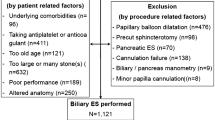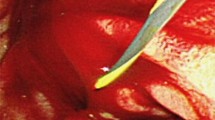Abstract
Background
Hemorrhage is one of the serious adverse events of endoscopic sphincterotomy (EST). However, the risk factors for delayed hemorrhage after EST have not been clarified. The aim of this study was to examine the risk factors for delayed hemorrhage after EST.
Methods
Consecutive patients who underwent EST between January 2011 and December 2015 were analyzed retrospectively. The incidence, treatment outcomes, and risk factors for delayed hemorrhage were evaluated. Delayed hemorrhage was defined as symptomatic hemorrhage occurring 24 h after an endoscopic procedure.
Results
After analyzing 1113 patients who underwent EST, delayed hemorrhage was seen to occur in 30 (2.7%) patients. The median period before presentation of delayed hemorrhage was 2 days (range 1–6) after EST, and its severity was mild in four, moderate in 20, and severe in six patients. All patients with delayed hemorrhage received successful endoscopic hemostasis. Univariate analysis showed that delayed hemorrhage occurred more frequently in patients with hemodialysis (p = 0.013), heparin replacement of antithrombotic agents (p = 0.012), or early hemorrhage occurring just after EST (p < 0.001). Among these, hemodialysis (OR 6.44, 95% CI 1.67–24.8; p = 0.007), heparin replacement (OR 3.76, 95% CI 1.42–9.98; p = 0.008), and early hemorrhage (OR 4.35, 95% CI 1.90–9.96; p < 0.001) proved to be independent risk factors for delayed hemorrhage on multivariate analysis.
Conclusions
The incidence of delayed hemorrhage after EST was 2.7%. Hemodialysis, heparin replacement, and early hemorrhage were the risk factors for delayed hemorrhage.


Similar content being viewed by others
References
Kawai K, Akasaka Y, Murakami K, et al. Endoscopic sphincterotomy of the ampulla of Vater. Gastrointest Endosc. 1974;20:148–51.
Classen M. Demling L [Endoscopic sphincterotomy of the papilla of vater and extraction of stones from the choledochal duct (author’s transl)]. Dtsch Med Wochenschr. 1974;99:496–7.
Rabenstein T, Schneider HT, Hahn EG, et al. 25 years of endoscopic sphincterotomy in Erlangen: assessment of the experience in 3498 patients. Endoscopy. 1998;30:A194–201.
Freeman ML, Nelson DB, Sherman S, et al. Complications of endoscopic biliary sphincterotomy. N Engl J Med. 1996;335:909–18.
Seifert E. Long-term follow-up after endoscopic sphincterotomy (EST). Endoscopy. 1988;20(Suppl 1):232–5.
Watanabe H, Yoneda M, Tominaga K, et al. Comparison between endoscopic papillary balloon dilatation and endoscopic sphincterotomy for the treatment of common bile duct stones. J Gastroenterol. 2007;42:56–62.
Disario JA, Freeman ML, Bjorkman DJ, et al. Endoscopic balloon dilation compared with sphincterotomy for extraction of bile duct stones. Gastroenterology. 2004;127:1291–9.
Fujita N, Maguchi H, Komatsu Y, et al. Endoscopic sphincterotomy and endoscopic papillary balloon dilatation for bile duct stones: a prospective randomized controlled multicenter trial. Gastrointest Endosc. 2003;57:151–5.
Barthet M, Lesavre N, Desjeux A, et al. Complications of endoscopic sphincterotomy: results from a single tertiary referral center. Endoscopy. 2002;34:991–7.
Loperfido S, Angelini G, Benedetti G, et al. Major early complications from diagnostic and therapeutic ERCP: a prospective multicenter study. Gastrointest Endosc. 1998;48:1–10.
Deans GT, Sedman P, Martin DF, et al. Are complications of endoscopic sphincterotomy age related? Gut. 1997;41:545–8.
Bergman JJ, Rauws EA, Fockens P, et al. Randomised trial of endoscopic balloon dilation versus endoscopic sphincterotomy for removal of bile duct stones. Lancet. 1997;349:1124–9.
Cotton PB, Lehman G, Vennes J, et al. Endoscopic sphincterotomy complications and their management: an attempt at consensus. Gastrointest Endosc. 1991;37:383–93.
Nelson DB, Freeman ML. Major hemorrhage from endoscopic sphincterotomy: risk factor analysis. J Clin Gastroenterol. 1994;19:283–7.
Kim KO, Kim TN, Kim SB, et al. Characteristics of delayed hemorrhage after endoscopic sphincterotomy. J Gastroenterol Hepatol. 2010;25:532–8.
Wilcox CM, Canakis J, Monkemuller KE, et al. Patterns of bleeding after endoscopic sphincterotomy, the subsequent risk of bleeding, and the role of epinephrine injection. Am J Gastroenterol. 2004;99:244–8.
Sherman S, Hawes RH, Nisi R, et al. Endoscopic sphincterotomy-induced hemorrhage: treatment with multipolar electrocoagulation. Gastrointest Endosc. 1992;38:123–6.
Fujimoto K, Fujishiro M, Kato M, et al. Guidelines for gastroenterological endoscopy in patients undergoing antithrombotic treatment. Dig Endosc. 2014;26:1–14.
Hamada T, Yasunaga H, Nakai Y, et al. Bleeding after endoscopic sphincterotomy or papillary balloon dilation among users of antithrombotic agents. Endoscopy. 2015;47:997–1004.
Lee MG, Kim J, Lee SH, et al. Effect of sustained use of platelet aggregation inhibitors on post-endoscopic sphincterotomy bleeding. Dig Endosc. 2014;26:737–44.
Onal IK, Parlak E, Akdogan M, et al. Do aspirin and non-steroidal anti-inflammatory drugs increase the risk of post-sphincterotomy hemorrhage–a case-control study. Clin Res Hepatol Gastroenterol. 2013;37:171–6.
Hussain N, Alsulaiman R, Burtin P, et al. The safety of endoscopic sphincterotomy in patients receiving antiplatelet agents: a case-control study. Aliment Pharmacol Ther. 2007;25:579–84.
Hui CK, Lai KC, Yuen MF, et al. Does withholding aspirin for one week reduce the risk of post-sphincterotomy bleeding? Aliment Pharmacol Ther. 2002;16:929–36.
Rabenstein T, Schneider HT, Bulling D, et al. Analysis of the risk factors associated with endoscopic sphincterotomy techniques: preliminary results of a prospective study, with emphasis on the reduced risk of acute pancreatitis with low-dose anticoagulation treatment. Endoscopy. 2000;32:10–9.
Cotton PB, Eisen GM, Aabakken L, et al. A lexicon for endoscopic adverse events: report of an ASGE workshop. Gastrointest Endosc. 2010;71:446–54.
Kanda Y. Investigation of the freely available easy-to-use software ‘EZR’ for medical statistics. Bone Marrow Transplant. 2013;48:452–8.
Leung JW, Chan FK, Sung JJ, et al. Endoscopic sphincterotomy-induced hemorrhage: a study of risk factors and the role of epinephrine injection. Gastrointest Endosc. 1995;42:550–4.
Kuran S, Parlak E, Oguz D, et al. Endoscopic sphincterotomy-induced hemorrhage: treatment with heat probe. Gastrointest Endosc. 2006;63:506–11.
Oviedo JA, Barrison A, Lichtenstein DR. Endoscopic argon plasma coagulation for refractory postsphincterotomy bleeding: report of two cases. Gastrointest Endosc. 2003;58:148–51.
Baron TH, Norton ID, Herman L. Endoscopic hemoclip placement for post-sphincterotomy bleeding. Gastrointest Endosc. 2000;52:662.
Itoi T, Yasuda I, Doi S, et al. Endoscopic hemostasis using covered metallic stent placement for uncontrolled post-endoscopic sphincterotomy bleeding. Endoscopy. 2011;43:369–72.
Shah JN, Marson F, Binmoeller KF. Temporary self-expandable metal stent placement for treatment of post-sphincterotomy bleeding. Gastrointest Endosc. 2010;72:1274–8.
Maleux G, Bielen J, Laenen A, et al. Embolization of post-biliary sphincterotomy bleeding refractory to medical and endoscopic therapy: technical results, clinical efficacy and predictors of outcome. Eur Radiol. 2014;24:2779–86.
Saeed M, Kadir S, Kaufman SL, et al. Bleeding following endoscopic sphincterotomy: angiographic management by transcatheter embolization. Gastrointest Endos. 1989;35:300–3.
Sulkowski U, Kautz G, Nottberg H. Surgical therapy of hemorrhage after endoscopic sphincterotomy. Indications and technique. Chirurg. 1996;67:26–31.
Remuzzi G, Livio M, Marchiaro G, et al. Bleeding in renal failure: altered platelet function in chronic uraemia only partially corrected by haemodialysis. Nephron. 1978;22:347–53.
Douketis JD, Spyropoulos AC, Kaatz S, et al. Perioperative bridging anticoagulation in patients with atrial fibrillation. N Engl J Med. 2015;373:823–33.
Acknowledgements
We would like to thank all of the participating patients.
Authors’ contribution
SI contributed to acquisition, analysis, and interpretation of data, and wrote the initial draft of the manuscript. AK designed the study. AK and TK critically reviewed the manuscript. All authors read and approved the final manuscript.
Author information
Authors and Affiliations
Corresponding author
Ethics declarations
Conflict of interest
The authors declare that they have no conflicts of interest.
Rights and permissions
About this article
Cite this article
Ikarashi, S., Katanuma, A., Kin, T. et al. Factors associated with delayed hemorrhage after endoscopic sphincterotomy: Japanese large single-center experience. J Gastroenterol 52, 1258–1265 (2017). https://doi.org/10.1007/s00535-017-1347-9
Received:
Accepted:
Published:
Issue Date:
DOI: https://doi.org/10.1007/s00535-017-1347-9




